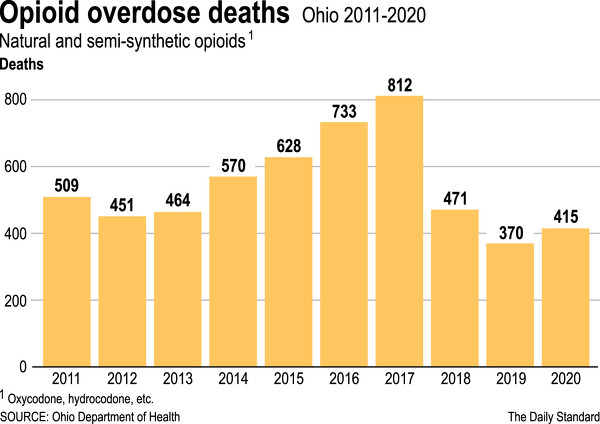Tuesday, January 18th, 2022
Opioid Windfall
Counties to discuss how to spend drug settlement millions
By William Kincaid

Photo by Daily Standard Staff
Opioid overdose death in Ohio.
CELINA - Mercer and Auglaize counties are part of a nine-county cluster that will have a say in how millions of dollars from opioid lawsuit settlements will be spent within the region.
Region 15, as it's known, also will appoint a member and recommend projects for funding to a 29-member statewide foundation board, as part of the OneOhio plan. The plan was developed by the Ohio Governor's Office, Ohio Attorney General's Office and local community leaders to jointly approach settlement negotiations with the drug manufacturers and distributors of opioids, according to a news release from Ohio Gov. Mike DeWine.
Region 15 is made up of Mercer, Darke, Preble, Allen, Auglaize, Shelby, Miami, Logan and Champaign counties. The region could receive up to $15 million.
"We are the leader in the nation. I don't believe any other state has come to a consensus on how to distribute these funds," county assistant prosecutor Amy Ikerd said about the OneOhio plan.
Under the plan, 30% of funds from any opioid settlement will be set aside for community recovery, money that will go directly to every township, village, city and county in Ohio to address the immediate needs of residents, according to a news release from DeWine.
Also, 55% of funds from such settlements will be set aside for the creation of a statewide foundation that will develop and oversee the funding of short-term and long-term planning local communities need to continue to address the opioid crisis, the release states.
The state of Ohio is divided into 19 regions, with eight of them consisting of single or two-county metropolitan regions and 11 consisting of multiple counties. Each region is responsible for creating its own governance structure to ensure all local governments have input and fair representation regarding regional decisions, including representation on the board and selection of projects to be funded from the region's regional share, according to information provided by county officials.
If the statewide foundation board determines a project meets the settlement's approved purposes, the project will be funded, according to an OneOhio overview presented at the County Commissioners Association of Ohio's annual business meeting.
Finally, 15% of funds from such settlements will go to the state to be used to leverage statewide buying power to offer prevention, treatment and recovery support services, according to the release.
Region 15 is poised to receive up to $15 million from the "Big Three" settlement involving drug distribution companies AmerisourceBergen, Cardinal Health and McKesson, according to Ikerd.
At a recent region 15 meeting, county representatives agreed to form a regional organizational structure, according to Ikerd, who attended the meeting with county commissioner Greg Homan.
"We are the largest region in the state of Ohio and also the first multi-county to come to an agreement," Ikerd said. "Almost every single county in our region was represented … and it was a unanimous consent to the organizational structure which is every county will have one vote on the committee but each county will have three representatives."
In Mercer County, one representative to region 15 will be chosen by county commissioners, one by the municipalities and one by the townships, she said. Officials hope to see representatives appointed to region 15 in the next few months.
"They'll be looking at proposals on how to spend the money. The money has certain guardrails on it. It can only be spent to alleviate the opioid epidemic in some fashion," Ikerd said. "They'll be looking at proposals on how to best do it for the entire region."
According to the OneOhio agreement, approved purchases of settlement funds include evidence-based forward looking strategies, programs and services to expand treatment, development and promotion of substance abuse prevention strategies and avoidance and awareness education and decreasing the oversupply of legal and illicit opioids.
Local governments also will be permitted to use the funds to reimburse for past expenditures related to the opioid epidemic. For instance, the anti-overdose drug Narcan could theoretically be considered an opioid epidemic-related expenditure.
"The OneOhio plan requires that this be a private nonprofit that's created and while we have started the process of organizing our region, we're still waiting on the organizational documents from the … statewide foundation," Ikerd said. "It's not clear how much the bylaws will impact the interpretation of how the money should be spent."
All other future opioid settlements would by divided up with the same formula established in the OneOhio plan, Ikerd said.
"The funds will be coming in over an 18-year-period," she said. "It's really designed with the hope that the money will stay focused on fixing the opioid epidemic. They don't want to see it hijacked and used to balance someone's budget."
Ikerd said those at the region 15 meeting were cooperative and appeared to understand the importance of best using the money to fight to the opioid epidemic.
"I think they were optimistic," she said. "We're trying to anticipate all of the problems that could arise and that's a hard thing to do."
Ohio Attorney General Dave Yost in September heralded Ohio's $808 million settlement with distributors Cardinal Health, McKesson and AmerisourceBergen.
Ikerd spoke in general about resolved and ongoing opioid epidemic litigation.
"This is considered the most complex litigation in the nation's history bar none," she said. "The national litigating attorneys have done an excellent job of bringing this to some sort of closure. I don't know that there's ever going to be enough money to really fix this problem but the amount of money is significant and I think will do good for the county and do good for the state of Ohio."

